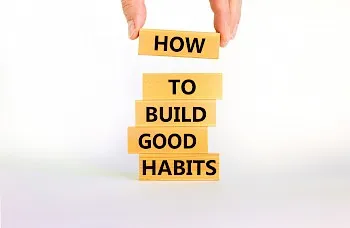How To Use Habit Stacking to Skyrocket Productivity In 2024
Table of contents

Habit stacking is leveraging an existing habit to build a new one by stacking the new one on the existing one. Increase productivity by defining your goals, identifying jump off goals, and start stacking new goals with your existing goals.
Habits play a significant part in productivity. You can be a productivity powerhouse with the proper habits, while the wrong ones can hold you back from becoming your most productive self. And if you want to form the kind of habits that skyrocket your productivity, there’s a strategy you need to know about: habit stacking. Habit stacking is an ingenious way to leverage your existing habits to build the habits you need to take your productivity to the next level.
But what, exactly, is habit stacking? How does it work? And how can you use it to skyrocket your productivity in 2024 (and beyond)?
What is habit stacking?

First things first. Before we jump into how to use habit stacking to skyrocket your productivity, let’s quickly touch on what habit stacking is.
Habit stacking is a concept popularized by productivity and self-improvement expert James Clear in his book(opens in a new tab) Atomic Habits(opens in a new tab). Habit stacking is leveraging an existing habit to build a new one by stacking the new one on the existing one. Or, as Clear describes it, “One of the best ways to build a new habit is to identify a current habit you already do each day and then stack your new behavior on top. This is called habit stacking.”
So, what does habit stacking look like in action? Clear developed a formula:
After/Before [Current Habit], I will [NEW HABIT].
So, using that formula, some examples of habit stacking might include:
- After I drink my morning coffee, I will walk outside for a 10-minute walk.
- Before I check social media, I will set a five-minute timer to remind me to return to my more productive work.
- After I shut down my computer at the end of the workday, I will turn off notifications on my Slack channel and email.
The key to successfully using habit stacking to develop new habits is to start with habits that are already a part of your daily routine and don’t require any effort to perform. They’re automatic—for example, brushing your teeth, making coffee, or checking your email.
One cool feature of habit stacking? Once you get the hang of it (and your new habits start to feel more ingrained and automatic), you can begin to chain behaviors together to create longer, more involved habit stacks—which can help ramp up your productivity and help you hit your goals.
So, for example:
- After I drink my coffee in the morning, I will walk outside for a 10-minute walk.
- After I go for a 10-minute walk outside, I will read a business or self-improvement book for 15-minutes.
- After I finish reading my business or self-improvement book, I will spend 10 minutes responding to emails.
- After I finish responding to emails, I will turn off email notifications until 12 pm.
- After I turn off email notifications, I will set an alarm for 12 pm.
- After I set my alarm, I will work on project work until it goes off.
Habit stacking can be a powerful tool for forming new habits. But how, exactly, can you use habit stacking to dramatically increase your productivity?
Define your goals.

Productivity means different things to different people. So before you can use habit stacking to increase productivity, you have to define what increasing productivity looks like for you.
Or in other words, you need to get clear on your goals—and what kind of habits will help you achieve those goals.
For example, your idea of increasing productivity might mean cutting back on the time you spend mindlessly checking social media or surfing the internet—in which case you’d probably want to build habits around limiting screen time or practicing mindfulness.
Or maybe you want to use exercise (and the endorphin boost that comes with it!) to increase your overall productivity. In that case, you’d want to build new habits that make fitness a more regular part of your daily routine.
The point is that you can’t use habit stacking to become more productive if you don’t know exactly how you want to be more productive. So before you start your habit stacking practice, make sure to define your goals—and what kind of habits you want to cultivate to achieve those goals.
Identify your jumping-off habits.

Once you know what you’re trying to accomplish (and what kind of habits will help you get there), it’s time to identify the existing habits that will act as the foundation of your habit stacking practice.
Again, the key to success with habit stacking—at least when you’re getting started—is to start with habits that are so ingrained in your daily routine that they happen automatically. While these habits will vary from person to person, some common habits that work well for habit stacking include:
- Turning off your morning alarm
- Making/drinking coffee
- Brushing your teeth
- Washing your face
- Taking a shower
- Feeding a pet
- Checking your email
Bottom line? If you want to successfully use habit stacking to ramp up your productivity, the best thing you can do is start with the habits that are already such an ingrained part of your routine, there’s a near zero percent chance you’re not going to do them daily.
Start stacking other habits on top that help you hit your productivity goals.

Once you’ve identified the habits you will use as a jumping-off point, it’s time to move on to the next step of the process—actually stacking your habits.
Again, the habits that you stack on top of your existing habits will depend on what you’re trying to achieve. But if you want your new habits to stick? Start small.
So, for example, if you’re currently living a pretty sedentary lifestyle—and want to use exercise to increase energy and productivity—don’t start with “after I brush my teeth, I will run seven miles.” Instead, start with something more manageable that you’ll be able to do consistently—like “after I brush my teeth, I will do ten squats” or “after I brush my teeth, I will do five minutes of stretching.”
Or let’s say you feel disconnected from your team—and you want to use habit stacking to foster better, more frequent communication with your colleagues. In that situation, you might start with something like “after I sign on for the day, I will message one person on my team to ask how their morning is going”—not “after I sign on for the day, I will message every co-worker on my team to ask how their morning is going.”
By starting small and ensuring your new habit is manageable, you’ll make it easier for that new habit to become just as ingrained as the original habit—and once that happens, you can stack another habit on top of it for even better results (for example, “after I brush my teeth, I will do five minutes of stretching—and after I do five minutes of stretching, I will do a 15-minute jog,” or “after I sign on for the day, I will message one person on my team to ask how their morning is going—and after I ask them how their morning is going, I will reach out to one additional colleague and ask the same.”).
Use habit stacking to take your productivity to the next level
Cultivating the right habits is a key part of being a productive person. And now that you understand how to use habit stacking to form the habits you need to take your productivity to the next level, all that’s left to do? Get out there and start stacking those habits!







